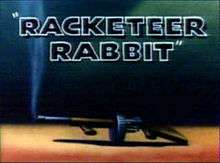Racketeer Rabbit
Racketeer Rabbit is a 1946 Warner Bros. Looney Tunes cartoon directed by Friz Freleng.[1] The short was released on September 14, 1946, and stars Bugs Bunny.[2]
| Racketeer Rabbit | |
|---|---|
 Title card | |
| Directed by | I. Freleng |
| Produced by | Edward Selzer (uncredited) |
| Story by | Michael Maltese |
| Starring | Mel Blanc Dick Nelson (uncredited) |
| Music by | Carl Stalling |
| Animation by | Gerry Chiniquy Manuel Perez Ken Champin Virgil Ross |
| Layouts by | Hawley Pratt |
| Backgrounds by | Paul Julian |
| Color process | Technicolor |
Production company | |
| Distributed by | Warner Bros. The Vitaphone Corporation |
Release date |
|
Running time | 8 minutes |
| Language | English |
In the cartoon, Bugs duels with a pair of racketeers or gangsters, Rocky and Hugo, forerunners of Rocky and Mugsy who resemble Edward G. Robinson (Rocky,[3] not to be confused with the aforementioned Rocky) and Peter Lorre (Hugo).[4] The short was written by Michael Maltese; animated by Manuel Perez, Virgil Ross, Gerry Chiniquy and Ken Champin; music by Carl Stalling, and voices by Mel Blanc and, uncredited, Dick Nelson (as "Robinson").
Plot
Bugs Bunny, looking for a place to spend the night, happens in an abandoned gothic farmhouse, which, unbeknownst to Bugs, is the hideout of two gangsters, Rocky and Hugo. Shortly thereafter, Rocky and Hugo return pursued by rival gangsters. The running gunfight continues as they take cover inside the farmhouse; Bugs comically gets up in the middle of the gunfight to use the bathroom and get a glass of water before returning to bed just as the shooting ends.
Later while Rocky is doling out his and Hugo's shares of the money from the heist they just pulled, Bugs slyly cuts in after noticing Rocky is not paying attention. He poses as several gang members until he gets all of the money. Rocky then wises up, and demands the money back. When Bugs refuses, Rocky has Hugo take Bugs for a ride. Bugs returns to the house without Hugo (who is absent from the rest of the cartoon, his fate unknown), and Rocky at first does not notice. When he does, he demands to know where the "dough" is, and after promising not to look (since Bugs does not want him to know where he hid it) gets a bowl of pie-dough in the face.
Bugs then poses as Mugsy, another gangster, who threatens that "It's curtains for you, Rocky", and then pulls an actual set of curtains from inside his jacket and hangs them over Rocky's head. Bugs then pretends to be the police, and has Rocky hide inside a chest while he "deals with" the police. Bugs acts out the police breaking in, ensuing in a fight over the chest which he is in, and play-acts a fight in which he eventually throws the cop out the window. Before the phony fight, Bugs opens the chest and hands Rocky a time bomb, which soon detonates and leaves Rocky's clothes in shreds.
Rocky flees the house, not wanting to be left "with that crazy rabbit". Bugs sighs, "Some guys just can't take it, see? Yeah, yeah, yeah, yeah!".
Analysis
Bugs Bunny impersonates Bugsy Siegel and flips a coin like George Raft in Scarface (1932). His Brooklynite accent serves to complete the image of a tough crook.[3]
See also
- List of Bugs Bunny cartoons
- Bugs and Thugs in which Bugs Bunny treats Rocky and Mugsy to hide the villains' routine
- Bah, Humduck! A Looney Tunes Christmas in which Bugs Bunny treats Daffy Duck to hide the villains' routine
References
- Beck, Jerry; Friedwald, Will (1989). Looney Tunes and Merrie Melodies: A Complete Illustrated Guide to the Warner Bros. Cartoons. Henry Holt and Co. p. 171. ISBN 0-8050-0894-2.
- Lenburg, Jeff (1999). The Encyclopedia of Animated Cartoons. Checkmark Books. pp. 58–62. ISBN 0-8160-3831-7. Retrieved 6 June 2020.
- Rubin, Rachel (2000). "A Gang of Little Yids". Jewish Gangsters of Modern Literature. University of Illinois Press. p. 104. ISBN 9780252025396.
- Youngkin, Stephen D. (2005). "Being Slapped and Liking It". The Lost One: A Life of Peter Lorre. University Press of Kentucky. p. 214. ISBN 9780813137001.